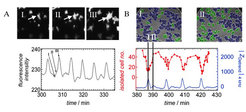Mechanics and dynamics of biological adhesion
Mechanics and dynamics of cellular contacts
D. d. also synchronizes itself during starvation inducing waves of cAMP. We have quantified these collective phenomena on the intercellular level by applying electric impedance measurements. We showed that cells seeded on micrometer-sized gold electrodes provoke impedance oscillations [1]. We record time dependent correlation of Electrical-Cell-substrate Impedance Sensing (ECIS) signals [2, 3] and changes in height detected by TIRF-microscopy by comparing light intensity of subtracted BF images from both assays. A high impedance signal IZI is found to correlate with a high fluorescence intensity and thus with a small cell-surface-distance

